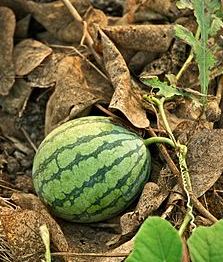Water Melon ( Citrullus vulgaris )
 Watermelon is thought to have originated in southern Africa, where it is found growing wild. It reaches maximum genetic diversity there, with sweet, bland and bitter forms. In the 19th century, Alphonse de Candolle[1] considered the watermelon to be indigenous to tropical Africa.[2] Though Citrullus colocynthis is often considered to be a wild ancestor of watermelon and is now found native in north and west Africa, it has been suggested on the basis of chloroplast DNA investigations that the cultivated and wild watermelon diverged independently from a common ancestor, possibly C. ecirrhosus from Namibia.[3]
Evidence of its cultivation in the Nile Valley was found from the second millennium BC. Watermelon seeds have been found at Twelfth Dynasty sites and in the tomb of Pharaoh Tutankhamun.[4] Watermelon is also mentioned in the Bible as a food eaten by the ancient Israelites while they were in bondage in Egypt.[5]
By the 10th century, watermelons were being cultivated in China, which is today the world's single largest watermelon producer. By the 13th century, Moorish invaders had introduced the fruit to Europe; according to John Mariani's Dictionary of American Food and Drink, "watermelon" made its first appearance in an English dictionary in 1615.
Watermelons were grown by Native Americans in the 16th century. Early French explorers found the fruit being cultivated in the Mississippi Valley. Many sources list the watermelon as being introduced in Massachusetts as early as 1629. Southern food historian John Egerton has said he believes African slaves helped introduce the watermelon to the United States. Texas Agricultural Extension horticulturalist Jerry Parsons lists African slaves and European colonists as having distributed watermelons to many areas of the world. Parsons also mentions the crop being farmed by Native Americans in Florida (by 1664) and the Colorado River area (by 1799). Other early watermelon sightings include the Midwestern states (1673), Connecticut (1747) and the Illiana region (1822).
Charles Fredric Andrus, a horticulturist at the USDA Vegetable Breeding Laboratory in Charleston, South Carolina, set out to produce a disease-resistant and wilt-resistant watermelon. The result, in 1954, was "that gray melon from Charleston". Its oblong shape and hard rind made it easy to stack and ship. Its adaptability meant it could be grown over a wide geographical area. It produced high yields and was resistant to the most serious watermelon diseases: anthracnose and fusarium wilt.[6]
Today, farmers in approximately 44 states in the US grow watermelon commercially, and almost all these varieties have some 'Charleston Gray' in their lineage. Georgia, Florida, Texas, California and Arizona are the US's largest watermelon producers. This now-common watermelon is often large enough that groceries often sell half or quarter melons. Some smaller, spherical varieties of watermelon, both red- and yellow-fleshed, are sometimes called "icebox melons".
Watermelon is thought to have originated in southern Africa, where it is found growing wild. It reaches maximum genetic diversity there, with sweet, bland and bitter forms. In the 19th century, Alphonse de Candolle[1] considered the watermelon to be indigenous to tropical Africa.[2] Though Citrullus colocynthis is often considered to be a wild ancestor of watermelon and is now found native in north and west Africa, it has been suggested on the basis of chloroplast DNA investigations that the cultivated and wild watermelon diverged independently from a common ancestor, possibly C. ecirrhosus from Namibia.[3]
Evidence of its cultivation in the Nile Valley was found from the second millennium BC. Watermelon seeds have been found at Twelfth Dynasty sites and in the tomb of Pharaoh Tutankhamun.[4] Watermelon is also mentioned in the Bible as a food eaten by the ancient Israelites while they were in bondage in Egypt.[5]
By the 10th century, watermelons were being cultivated in China, which is today the world's single largest watermelon producer. By the 13th century, Moorish invaders had introduced the fruit to Europe; according to John Mariani's Dictionary of American Food and Drink, "watermelon" made its first appearance in an English dictionary in 1615.
Watermelons were grown by Native Americans in the 16th century. Early French explorers found the fruit being cultivated in the Mississippi Valley. Many sources list the watermelon as being introduced in Massachusetts as early as 1629. Southern food historian John Egerton has said he believes African slaves helped introduce the watermelon to the United States. Texas Agricultural Extension horticulturalist Jerry Parsons lists African slaves and European colonists as having distributed watermelons to many areas of the world. Parsons also mentions the crop being farmed by Native Americans in Florida (by 1664) and the Colorado River area (by 1799). Other early watermelon sightings include the Midwestern states (1673), Connecticut (1747) and the Illiana region (1822).
Charles Fredric Andrus, a horticulturist at the USDA Vegetable Breeding Laboratory in Charleston, South Carolina, set out to produce a disease-resistant and wilt-resistant watermelon. The result, in 1954, was "that gray melon from Charleston". Its oblong shape and hard rind made it easy to stack and ship. Its adaptability meant it could be grown over a wide geographical area. It produced high yields and was resistant to the most serious watermelon diseases: anthracnose and fusarium wilt.[6]
Today, farmers in approximately 44 states in the US grow watermelon commercially, and almost all these varieties have some 'Charleston Gray' in their lineage. Georgia, Florida, Texas, California and Arizona are the US's largest watermelon producers. This now-common watermelon is often large enough that groceries often sell half or quarter melons. Some smaller, spherical varieties of watermelon, both red- and yellow-fleshed, are sometimes called "icebox melons".




